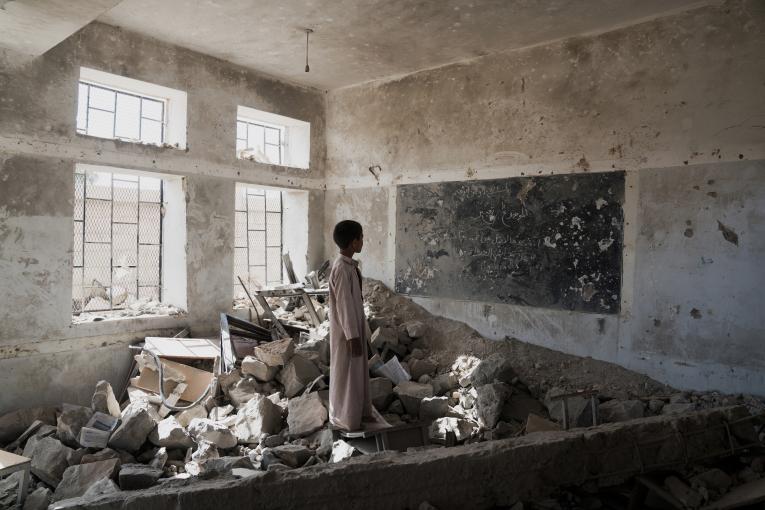GCPEA News
Pledging Conference Provides Opportunity to Safeguard Yemen’s Future by Protecting Education from Attack
GCPEA PRESS RELEASE, February 22, 2019
(February 20, 2019) Attacks on education in Yemen are exacerbating an already devastating crisis for education, said the Global Coalition to Protect Education from Attack (GCPEA) in a briefing paper, Safeguard Yemen’s Future: Protect Education from Attack, released today. According to Yemen’s Education Cluster, 2 million children are out of school today, compared to 1.6 million before the conflict. At the same time, the Cluster reports that 256 schools have been destroyed, and 1,520 damaged during the current armed conflict, which has lasted almost four years. Universities, their staff, and students have also been targeted.
GCPEA’s paper is being released ahead of the Third High Level Pledging Conference to support the humanitarian response in Yemen, which will be convened by the United Nations and the Governments of Sweden and Switzerland in Geneva, on February 26, 2019.
“The pledging conference provides a critical opportunity for the international community to commit to ending attacks on education in Yemen and ensuring that students can learn in safety,” said Diya Nijhowne, GCPEA executive director. “The right to education cannot be safeguarded without education itself being protected, and the country cannot rebuild without education being prioritized and secured.”
Airstrikes by the Saudi-led coalition have been the most prevalent risk to students and education personnel and facilities in Yemen, with the UN Secretary General attributing 57 percent of attacks on schools to the coalition in 2015, approximately 90 percent in 2016, and 95 percent in 2017. Airstrikes have sometimes caused significant casualties. A particularly devastating attack occurred on August 9, 2018, when the Saudi-led coalition struck a school bus carrying children on a special excursion. According to information verified by the Civilian Impact Monitor Project partners, 51 civilians, including 40 children, were killed, with many more injured.
Armed forces and armed groups have also used dozens of schools and universities for military purposes throughout the armed conflict, with the UN verifying 84 cases in 2015, and one to two dozen cases each year that followed. Some of these educational institutions have subsequently been targeted for attack by opposing forces. For example, Human Rights Watch reported that Houthi-Saleh forces were housing fighters and had established an office in a boarding school, the al-Noor Center for the Care and Rehabilitation for the Blind, when it was struck by the Saudi-led coalition in January 2016. Two staff members, an 18-year-old student, and a local resident were wounded. Fortunately, the bomb did not detonate, but its impact broke windows and blew out the doors in the school.
Armed parties have also targeted female education. Anecdotal cases include reports in November 2017 by principals and several district heads of education that numerous schools had received WhatsApp messages threatening that they would be bombed if girls continued to attend. In addition, there have been reports of gunmen demanding segregation of boys and girls in schools, and girls’ schools being attacked.
“Female students in Yemen have been directly targeted, and are often disproportionately impacted by attacks, including because they are more likely than boys to be kept home when there is a risk of sexual and other violence at school, and boys’ education is often prioritized when funds are limited,” said Nijhowne.“ Any strategy for protecting education must account for the ways that women and girls are targeted and the unique consequences they may face, including being less likely to return to school due to traditional gender roles, such as caring for families, as well as early marriage.”
Higher education has also been impacted by attacks on education, with university staff and students being forced to seek exile abroad because of physical destruction of universities and political pressures to align themselves politically and ideologically with parties to the conflict.
Yemeni government authorities in Aden have taken an important step towards protecting education by endorsing the Safe Schools Declaration, an international commitment to protect education in armed conflict that has been joined by 84 member states since being opened for endorsement in May 2015. The Declaration includes a commitment to use and operationalize the Guidelines for Protecting Schools and Universities from Military Use during Armed Conflict.
The authorities have taken steps to implement the Declaration, including by establishing a Safe Schools Committee within the Ministry of Education. Nonetheless, much more must be done by the authorities and the international community to continue, strengthen, and support implementation of the Declaration. In addition, Houthi authorities in Sana’a, along with all other parties to the conflict, should take concrete action to protect students, education personnel, schools, and universities, including by immediately ceasing to target educational institutions, and taking all precautions when attacking legitimate military targets near schools or universities.
“Education in armed conflict can provide a critical protective function for young people, providing a safe space away from the fighting, as well as routine, and a sense of normalcy that can build resiliency and offer other psycho-social benefits,” said Nijhowne. “At the upcoming pledging conference, it is crucial that donors commit to supporting measures to protect and rehabilitate the education sector, to ensure the capacity of the next generation to build their own future, and ultimately, Yemen’s.”





